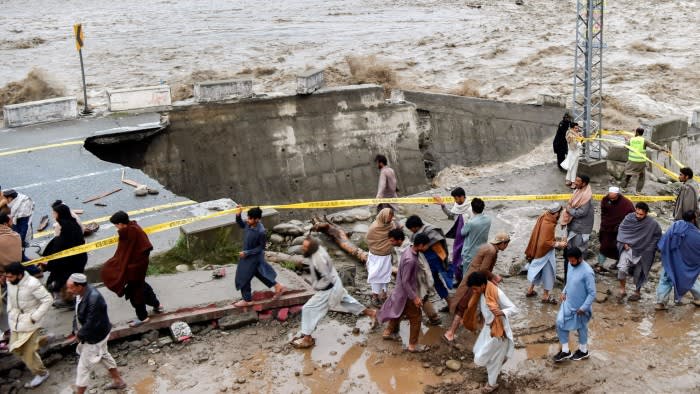Antibiotic-resistant “superbugs” are among the greatest public health threats of our age — and researchers fear that climate change will make them still more dangerous.
Higher temperatures, more flooding, rising pollution, and growing population crowding are all forecast to stoke bacterial resilience to existing drugs.
These problems add urgency to international efforts to tackle antimicrobial resistance (AMR) by developing new medicines, and by blocking the pathways through which pathogen immunity spreads. They also mean climate change will loom large when governments gather on the sidelines of the UN General Assembly, in September, to discuss ways to combat AMR.
“There are currently no good estimates of how much worse climate-related disasters will make the burden of resistance — but it is clear that the risks are very large,” says Anthony McDonnell, a senior policy analyst at the Center for Global Development, a Washington-based think-tank. “This area requires far more research to enable us to determine the tools needed to deal with this worrying inevitably.”
AMR refers to changes in bacteria, viruses, fungi, and parasites over time, as they evolve to develop resistance to the existing drugs used to tackle them. While the evolution itself is a natural response, it is accelerated by the extra exposure pathogens receive to medicines used too frequently or carelessly.
AMR contributed to almost 5mn deaths globally in 2019 and was directly responsible for more than a quarter of them, according to a 2022 study. It could result in $1tn extra annual healthcare costs by 2050 and $1tn to $3.4tn gross domestic product losses per year by 2030, the World Bank has estimated.
“The climate crisis has numerous impacts on ecosystems, human health, animal health and food production, which also affect AMR,” according to a report titled “Bracing for Superbugs” published last year by the UN Environment Programme.
AMR is most harmful in lower- and middle-income countries that are more vulnerable to the effects of climate change, such as flooding. Anti-microbial resistance to enteric fever — the waterborne disease also known as typhoid — has risen over the past 30 years in 75 countries in which it is endemic, according to a study published in The Lancet Global Health journal in February.
The results showed how rising resistance was a “pressing public health issue, jeopardising our ability to treat enteric fever effectively”, said Annie Browne, a spatial modeller and the lead author, on the study’s publication.
Pakistan, which suffered devastating floods in 2022, has a particularly stark problem with enteric fever AMR. Resistance of one typhoid-causing bacterium to the cephalosporin antibiotics used to combat it had risen as high as 61 per cent in the country by 2019, the researchers found.
‘The impact of AMR is disproportionately felt in regions where resources are limited, exacerbating inequalities,” added Sadia Shakoor, associate professor of microbiology at the Aga Khan University in Karachi, Pakistan, also involved in the research.
One problem is that global heating will tend to speed the growth of bacteria and their so-called horizontal gene transfer — the process by which they exchange genetic material between each other. Higher temperatures are “intimately linked” to AMR because of these twin associations, according to a paper published in the International Journal of Environmental Research and Public Health last year.
Greater rainfall and flooding will also increase the risks of horizontal gene transfer due to contamination of water supplies, either directly with antibiotics or human excreta containing traces of the drugs. Wastewater is a “reservoir for antibiotic-resistance genes” (ARGs), according to the environmental research journal’s paper.
Another proposed cause of the spread of AMR in wastewater is pollution by microplastics — fragments of debris from consumer products or industrial waste. They are believed to act as breeding grounds for bacteria, allowing them to form “biofilms” that facilitate the transfer of antibiotic-resistant genes.
Other pollutants may also play roles in the spread of AMR. These include heavy metals, such as those found in high concentrations in the UK’s River Tyne, due to historical mining and industrial activity, according to a 2022 paper published in the journal Environmental Pollution. Researchers found elevated levels of bacterial species that carry “gene cassettes” prone to spreading antibiotic resistance.
A further concern is that AMR could flourish because people’s immune systems will be weakened by climate change-related socio-economic effects. These include food shortages and population displacement due to natural disasters, or regions becoming uninhabitable because they are too hot.
However, experts believe that various changes in activity could help to curb the role of pollution in stoking AMR. These include better monitoring of wastewater composition, stricter limits on antibiotic residue discharges, and more research to establish accurately which pollution sources are the most damaging.
More broadly, scientists working on AMR urge the implementation of measures to mitigate the impact that floods and other extreme weather events will have on communities’ access to clean water and good sanitation.
The price of not acting, experts warn, is that essential medicines we have relied on for many years will become ineffective.
“Climate change and antimicrobial resistance are the two most pressing and interlinked global health challenges facing us today,” argues Alistair Farley, scientific lead at the UK’s Ineos Oxford Institute for antimicrobial research.
“It’s a Catch 22 situation, where increased global rates of infections and increased antibiotic consumption will ultimately lead to the drugs no longer working,” he says.
Climate Capital

Where climate change meets business, markets and politics. Explore the FT’s coverage here.
Are you curious about the FT’s environmental sustainability commitments? Find out more about our science-based targets here


